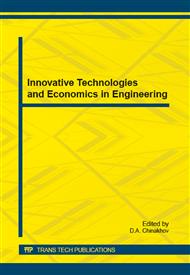[1]
A.D. Razmyshlyaev. Magnetic control of weld formation at arc welding, Mariupol, (2000).
Google Scholar
[2]
V.P. Chernysh, V.D. Kuznetsov, A.N. Briskman, G.M. Shelenkov. Welding with electromagnetic stirring, Kiev, (1983).
Google Scholar
[3]
J. C. Villafuerte, H. W. Kerr. Electromagnetic stirring and grain refinement in stainless steel GTA welds / Welding journal. – 69 (1990). – No. 1. – pp.1-13.
Google Scholar
[4]
M. Malinovski-Brodnicka, G. den Ouden, W. J. P. Vink. Effect of electromagnetic Stirring on GTA welds in austenitic stainless steel / Welding journal. – 69 (1990). – No. 2. – pp.52-59.
Google Scholar
[5]
A.M. Boldyrev, V.A. Birzhev, A.V. Chernykh. Improving the electrode wire melting productivity at welding in a longitudinal magnetic field / Welding production. – 1989. – No. 4. – 18-19.
DOI: 10.1080/09507119809447812
Google Scholar
[6]
A. M. Boldyrev, V.A. Birzhev, A.V. Chernykh. The penetration depth control in arc welding and surfacing with alternating longitudinal magnetic field / Welding production. – 1993. – No. 6. – pp.30-31.
Google Scholar
[7]
Y.H. Kang, S.J. Na. Characteristics of welding and arc signal in narrow groove gas metal arc welding using elecromagnetic arc oscillation / Welding Journal. – 82 (2003). – No. 5. – pp.93-99.
DOI: 10.1016/b978-008044066-8/50004-5
Google Scholar
[8]
A. D. Razmyshlyaev, M. V. Mironova. Magnetic control of formation of rollers and welds at arc surfacing and weldingl, Mariupol, (2009).
Google Scholar
[9]
Chinakhov D.A. Study of thermal cycle and cooling rate of steel 30ХГСА single-pass weld joints / Applied Mechanics and Materials. – Vols. 52-54. – 2011. – pp.442-447.
DOI: 10.4028/www.scientific.net/amm.52-54.442
Google Scholar
[10]
V. D. Kuznetsov, I. V. Malinkin, V. V. Syrovatka. Behaviors of the arc and transfer of electrode metal on welding process in a longitudinal magnetic field / Welding production. – 1972. – No. 4. – pp.3-4.
Google Scholar
[11]
B. N. Selyanenkov, V. A. Blinkov, U. V. Kazakov. About weld formation in a longitudinal magnetic field in argon arc welding / Welding production. – 1975. – No. 11. – pp.5-7.
Google Scholar
[12]
M. L. Lin, T. W. Eagar. Influence of arc pressure on weld pool geometry / Welding Journal. – 64 (1985). – No. 6. – pp.163-169.
Google Scholar
[13]
Z. Cao, Z. Yang, X. L. Chen. Three-Dimensional Simulation of Transient GMA Weld Pool with Free Surface / Welding Journal. – 83 (2004). – No. 6. – 169-176.
Google Scholar


